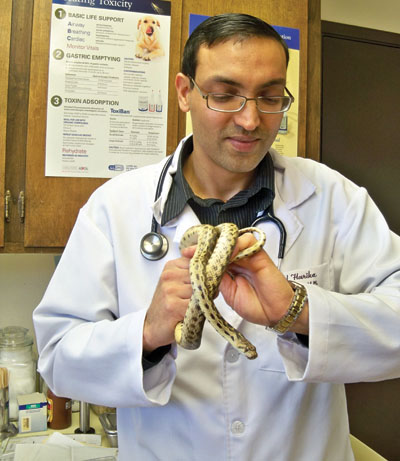The Wildlife Education and Rehabilitation Center’s first patient
of 2011 is a young gopher snake that arrived in January with wounds
on the top and bottom of its head. It’s likely that the injuries
were caused by the talons of a hawk, which would consider the
reptile a delicacy.
He eats the mouse with honey
It takes a little stealth
It makes the mouse taste funny
But we do it for his health
The Wildlife Education and Rehabilitation Center’s first patient of 2011 is a young gopher snake that arrived in January with wounds on the top and bottom of its head. It’s likely that the injuries were caused by the talons of a hawk, which would consider the reptile a delicacy. Or maybe the snake itself was the hunter and tried to bring down a rodent, which fought back with its incisors. The 3.5-foot-long snake was brought to Dr. Jaspal Harika of Morgan Hill Animal Hospital and given a thorough examination. Harika ascertained that its mouth was infected and prescribed antibiotic treatments. In addition to receiving injections under its scales every other day, the inside of the snake’s mouth was to be coated lightly with honey. Honey has been used for more than 2,000 years as a topical antiseptic in the treatment of wound infections in humans, and it appears to be quite effective on snakes, too.
Since it’s uncommon for a wild snake to eat early in its captivity, volunteers must hand-feed the snake bits of rodent. The taste of honey provides a bit of extra calories and nutrition, hastening the snake’s recovery. Before the snake can be released as planned this spring, when field rodents are abundant and the weather has warmed up, it must not only prove that he can eat by himself, but he has to get into good condition again by shedding his old skin and re-growing a missing tooth.
A fascinating footnote: Aesculapius, the Greek god of medicine, who not only healed the sick but restored the dead to life, held the snake sacred and it was considered the emblem of health and recovery. Doctors of the ancient world were well aware of the healing qualities of honey, which may be why in the mythology of Aesculapius, the snakes were fed on honey. Aesculapius is portrayed holding what is commonly called a caduceus – a winged staff entwined with two snakes – which is now an emblem of modern-day medicine.
***
Note to those who suffer from ophidiophobia (fear of snakes) and to ophiophilists (snake-lovers): Soon our cold, rainy winter will transform into warm, sunny spring and summer. People will be out tending their flower gardens, hiking in the wilderness or just walking around the neighborhood enjoying the weather. Reptiles, too, will be out taking advantage of the warmth. Since they’re ectothermic and can’t control their body temperatures, you just might come upon one warming itself on the sidewalk, road or path.
Please leave the critter alone. Except for the rattlesnake, all of our local native snakes (which include colorful varieties of king, garter, ringneck and sharptail snakes) are non-venomous. Snakes are an environmental boon, performing a valuable job of natural pest control. Gopher snakes, for one, can help rid an area of hill-raising, lawn-wrecking rodents, such as gophers and ground squirrels. The snakes live in a wide variety of habitats, but prefer grassland and open brush, the prime habitat of varmints as well.
Be aware though that a gopher snake can present an excellent mimicry of a rattlesnake. Not only do they have similar markings and coloring, but when the gopher snake is threatened by red-tailed hawks, coyotes and foxes (the snake’s primary predators), it will coil, flatten its head (resembling the triangular-shaped head of a venomous snake), vibrate its tail and make a rattle-like hissing sound. Rattlesnakes, of course, have actual rattles as warning noisemakers.










